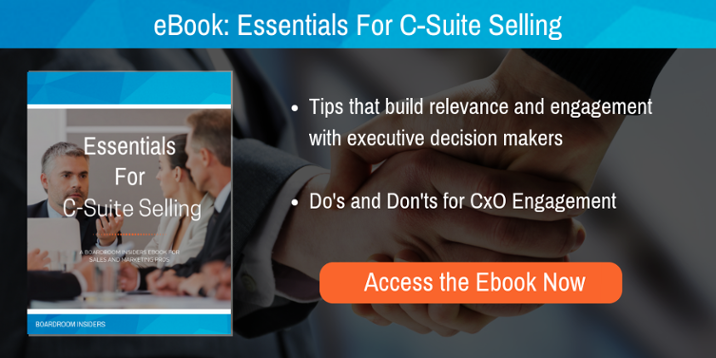
How prepared are your sales people for their hard-won meetings with prospective customers? According to IDC, nearly 57 percent of B2B prospects and customers feel that vendor sales teams are not prepared for the first meeting.
Preparation can mean a lot of things—fundamental knowledge of your product or service, customer-specific knowledge of the issues the product or service is expected to solve, as well as a thorough knowledge of the prospect’s history, current issues, priorities, and challenges. In short, a deep understanding of how what you are selling aligns with what the customer needs. Preparation may even be as basic as understanding the purpose of the meeting and who the players are.
Ned Daubney, a customer engagement consultant and strategist with Last Mile Research explains that customer intelligence failures often fuel dreadful and embarrassing outcomes. He has offered some pointed real-life examples of how customer intelligence failures kill deals.
- A large healthcare provider was considering moving its 85,000 employees from its longtime software suite to a newer Cloud-based suite. As the incumbent provider, Software Firm A came across a bit arrogant and overconfident that the provider would accept its terms. Firm B was invited to make their pitch and had a good shot at this annual $35 million opportunity, and the customer was actively rooting for them. But while Software Firm A diligently planned its executive briefing by working closely with the provider’s internal champion to set the right agenda, Firm B did nothing of the sort, instead simply giving the pitch it wanted to give, with little real effort to gauge the provider’s priorities, hot buttons, or end-goals. As such, Software Firm A’s extraordinary effort to deeply understand this key customer crushed what should have been a highly competitive battle. – A flashy briefing center and brand name and a high-energy hip environment are still no substitute for deeply understanding the customer.
- A process engineering software vendor in meeting with its largest customer discovered the customer had purchased a number of competitor solutions that the vendor had not even known was open for bid—suggesting that they were no longer on the customer’s “short list” for project bids. These numerous missed opportunities could have easily been uncovered and addressed by someone more closely monitoring the customer. This finding set off a firestorm internally for the vendor as they tried to learn what had happened to the relationship—and who was responsible for letting a key customer slowly slip away. – Customer analysis is not an annual event; it is a constant monitoring state.
- Daubney witnessed a Fortune 100 firm senior executive, in support of a regional sales team, fly cross-country to attend a regional executive briefing—and emphatically swore never to return to support this team as he witnessed an embarrassingly unprepared, unfocused team stumble its way through the meeting. - A poorly prepared sales team does more than just lose a deal, it loses the support and credibility of its own executives.
- A Sales Director for a PC manufacturer told Daubney of a time when a new sales rep offered to run an impromptu demo to a soon-to-be customer CEO, who was there simply to sign the contract based on the CIO’s recommendation. The CEO suddenly felt they missed some key features that he wanted and cancelled the deal. That rep was gone by the end of the day! - Despite the poor sales technique, the Sales rep should have known the risk of presenting anything to a CXO, about whom he knew nothing.
- Customer research should always also include internal research. A Sales VP of a major tech vendor recalled a recent engagement where the customer simply asked; “What else are you doing for other customers like us”? “And we all just sat there with blank looks. We should be ready with relative customer success stories – And we should be showing them the building blocks on how they could move with us next going forward, based on our case studies”. - You need to understand not only the customer (external research), but also your own relative built-up advantages and success stories (internal research).”
While each of these scenarios point out disparate points of failure, what they have in common is lack of preparation, of not paying attention to the details.
Jim Steele, of Yext, Inc., points out, “What motivates salespeople is the thrill, the rush, the living on the edge, the idea that they’re going to close the big one. It’s a hero mentality...” But those “heroes” will only succeed if they have the right tools. Adrenalin isn’t enough. Those tools include everything from in-depth knowledge about your prospect to why you’re actually there to meet with them. If your team isn’t armed with knowledge, they are doomed to fail.
How can you avoid these mortifying failures? One solution is to provide your teams with the most up-to-date research tools. Boardroom Insiders executive profiles are packed with details about both individual decision makers and their organizations. With this in-depth knowledge, your sales people will know what and who drive decisions, where your value to prospects lies, and gives sales teams the confidence and credibility they need to impress prospects and build relationships.
Boardroom Insiders is a leading source for insight about executive decision makers and their company strategies, initiatives, and challenges—just the type of insight you need to have successful conversations with busy executives. You can learn more about these new leaders—and more—by accessing their profiles at www.boardroominsiders.com. As a Boardroom Insiders customer, you can use our in-depth executive profiles to educate yourself about these and other key accounts to close bigger deals, faster.







Share Your Thoughts